The Borzoi (/ˈbɔːrzɔɪ/, literally “fast”), also called the Russian wolfhound (Russian: Ру́сская псовая борзая), is a breed of domestic dog (Canis lupus familiaris). Descended from dogs brought to [wiki title=”Russia ” base=”EN”]Russia[/wiki] from central Asian countries, it is similar in shape to a greyhound, and is also a member of the sighthound family.
The system by which Russians over the ages named their sighthounds was a series of descriptive terms, not actual names. “Borzói” is the masculine singular form of an archaic Russian adjective that means “fast”. “Borzáya sobáka” (“fast dog”) is the basic term used by Russians, though “sobáka” is usually dropped. The name “Psovaya” derived from the word Psovina, which means “wavy, silky coat”, just as “Hortaya” (as in Hortaya Borzaya) means shorthaired. In Russia today the breed we know as the borzoi is officially known as “Russkaya Psovaya Borzaya”. Other Russian sighthound breeds are “Stepnaya Borzaya” (from the steppe), called “Stepnoi”; and “Krimskaya Borzaya” (from the [wiki base=”EN”]Crimea[/wiki]), called “Krimskoi”.
The most commonly used plural form is the regular formation “borzois”, which is the only plural cited in most dictionaries. However, the Borzoi Club of America and the Borzoi Club UK both prefer “borzoi” as the form for both singular and plural forms.
Description
Appearance
Borzois are large Russian sighthounds that resemble some central Asian breeds such as the Afghan hound, Saluki, and the Kyrgyz Taigan. Borzois can generally be described as “long-haired greyhounds”. Borzois come in virtually any colour. The borzoi coat is silky and flat, often wavy or slightly curly. The long top-coat is quite flat, with varying degrees of waviness or curling. The soft undercoat thickens during winter or in cold climates, but is shed in hot weather to prevent overheating. In its texture and distribution over the body, the borzoi coat is unique. There should be a frill on its neck, as well as feathering on its hindquarters and tail.
Borzoi males frequently weigh more than 100 pounds (45 kg). Males stand at least 30 inches (76 cm) at the shoulder, while the height of females is around 26 inches (66 cm). Despite their size, the overall impression is of streamlining and grace, with a curvy shapeliness and compact strength.
Temperament
The borzoi is a quiet, but athletic and independent dog. Most borzois are almost silent, barking only very rarely. They do not have strong territorial drives and cannot be relied on to raise the alarm upon sighting a human intruder. The borzoi is extremely smart and requires patient, experienced handling. They are gentle and highly sensitive dogs with a natural respect for humans, and as adults they are decorative couch potatoes with remarkably gracious house manners. Borzois do not generally display dominance or aggression towards people, but will turn aggressive if handled roughly. Typically however, they are rather reserved with strangers but affectionate with people they know well. Their sensitivity to invasion of their personal space can make them nervous around children unless they are brought up with them. Despite their size, borzois adapt very well to suburban life, provided they have a spacious yard and regular opportunities for free exercise.
Health
Stated life expectancy is 10 to 12 years. Median lifespan based on a UK Kennel Club survey is 9 years 1 month. 1 in 5 died of old age, at an average of 10 to 11.5 years. The longest lived dog lived to 14 years 3 months. Dogs that are physically fit and vigorous in their youth through middle age are more vigorous and healthy as elderly dogs, all other factors being equal. In the UK, cancer and cardiac problems seem to be the most frequent causes of premature death.
Like its native relative the Hortaya Borzaya, the borzoi is basically a very sound breed. [wiki title=”Osteochondritis_dissecans” base=”EN”]OCD[/wiki], hip and [wiki title=”Elbow_dysplasia” base=”EN”]elbow dysplasia[/wiki] have remained almost unknown, as were congenital eye and heart diseases before the 1970s. However, in some countries modern breeding practices have introduced a few problems.
As with other very deep-chested breeds, [wiki title=”Gastric_dilatation_volvulus” base=”EN”]gastric dilatation volvulus[/wiki] (also known as bloat) is the most common serious health problem in the borzoi. This life-threatening condition is believed to be anatomical rather than strictly genetic in origin. One common recommendation in the past has been to raise the food bowl of the dog when it eats. However, studies have shown that this may actually increase the risk of bloat.
Less common are cardiac problems including [wiki title=”Cardiomyopathy” base=”EN”]cardiomyopathy[/wiki] and [wiki title=”Cardiac_arrhythmia” base=”EN”]cardiac arrhythmia[/wiki] disorders. A controversy exists as to the presence of [wiki title=”Progressive_retinal_atrophy” base=”EN”]progressive retinal atrophy[/wiki] in the breed. A condition identified as borzoi retinopathy is seen in some individuals, usually active dogs, which differs from progressive retinal atrophy in several ways. First, it is unilateral, and rarely seen in animals less than three years of age; second, a clear-cut pattern of inheritance has not been demonstrated; and finally, most affected individuals do not go blind.
Borzoi. (2017, June 15). In Wikipedia, The Free Encyclopedia. Retrieved from https://en.wikipedia.org/w/index.php?title=Borzoi&oldid=785812409


